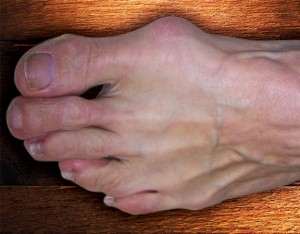 What Is A Bunion?
What Is A Bunion?
A bunion is one problem that can develop in the big toe. The bone which joins the big toe, the first metatarsal, becomes prominent on the inner border of the foot. This bump is the bunion and is made up of bone and soft tissue.
By far the most common cause of bunions is the prolonged wearing of poorly fitting shoes, usually shoes with a narrow, pointed toe box that squeezes the toes into an unnatural position. Heredity often plays a role in bunion formation. But these causes account for only a small percentage of bunions.
A study by the American Orthopaedic Foot and Ankle Society found that 88 percent of women in the U.S. wear shoes that are too small and 55 percent have bunions. Not surprisingly, bunions are nine times more common in women than men.
Can Bunions Be Prevented?
Bunions often become painful if they are allowed to progress. But not all bunions progress. Many bunion problems can be managed without surgery. In general, bunions that are not painful do not need surgical correction.
Bunion pain can be successfully managed in the vast majority of cases by switching to shoes that fit properly and don’t compress the toes. Your Orthopaedic Clinic doc-tor can give you more information about proper shoe fit and the types of shoes that would be best for you.
Some shoes can be modified by stretching the areas that put pressure on your toes. Splints to reposition the big toe and orthotics (special shoe inserts shaped to your feet) also may relieve pain. For bunions caused by arthritis, medications can be prescribed to reduce pain and swelling.
Is Bunion Surgery For You?
If nonsurgical treatment fails, your Orthopaedic Clinic doctor may recommend surgery. Many studies have found that 85 to 90 percent of patients who undergo bunion surgery are satisfied with the results. Reasons that you may benefit from bunion surgery commonly include:
- Severe foot pain that limits your everyday activities
- Chronic big toe inflammation and swelling
- Toe deformity
- Toe stiffness
- Failure to substantially improve with other treatments
As you explore bunion surgery, be aware that so-called “simple” or “minimal” surgical procedures are often inadequate “quick fixes” that can do more harm than good. And beware of unrealistic claims that surgery can give you a “perfect” foot.
If you are interested in exploring bunion surgery, come visit our experienced and highly trained surgeons at The Orthopaedic Clinic for a consultation.
Follow these general points of shoe fit:
- Judge the shoe by how it fits on your foot, not the size.
- Select a shoe that conforms to the shape of your foot.
- Have your feet measured regularly.
- Have both feet measured. Fit to the largest foot.
- Fit at the end of the day when your feet are the largest.
- Stand during the fitting process.
- Make sure the ball of your foot fits well into the widest part of the shoe.
- Do not purchase shoes that feel too tight.
- Your heel should fit comfort-ably in the shoe with a mini-mum amount of slippage.
- Walk in the shoe to make sure it fits and feels right.
